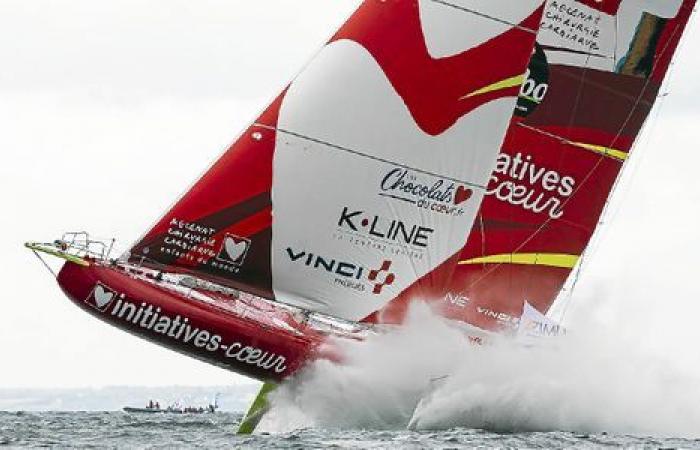A little flashback, in December 2023: on Le Retour à La Base, a solo race between Martinique and Lorient. Aboard his foiling Imoca, Sébastien Simon makes yet another crash. In one of them, he fell violently. Total blackout. “I regained consciousness with a face full of blood.” He has a big wound on his head. With the stapler from the first aid kit, he puts “about ten staples on his head”. He doesn't know it yet, but his 7th vertebra is fractured, which will force him to wear a corset for three months.
This accident changed everything for Sablais who had a molded seat made, mounted on shock absorbers. The life cell of his boat was cut in two using nets, in order to be slowed down in the event of an impact and not to be thrown against a wall.
On this same deckchair, Romain Attanasio also split his skull after a violent crash. Bleeding, the skipper lost consciousness twice: “It took me a little time to regain my senses, I no longer knew where I was.” A few minutes earlier, the Lorient resident remembers seeing the speedometer display a peak of 38.5 knots. Or 71 km/h. A crash at sea is like driving down an embankment. The deceleration is brutal.
In both cases, the race doctor applied the concussion protocol. Like in rugby. Following this shock, Attanasio put foam everywhere inside his cockpit, he also added a seat belt to his watch seat.
Victim of a collision during a stage of The Ocean Race, Charlie Dalin now wears a hard helmet and no longer a rugby helmet. “We also reduced the size of the cockpit, which limits the distance if I fall.”
The skipper of Macif also had a custom seat built with shock absorber and safety belt. The tendency is to protect the skipper, not to slow down a boat without brakes. “We never tried to slow down a boat while racing,” admits Attanasio. Fatal accidents in Formula 1 have changed the rules. Will sailing have to wait for a tragedy to follow the same path? Attanasio does not dodge the question: “We keep wondering when the moment will arrive when we will have to slow down because the man will no longer hold out”.
Jean Le Cam affirms that “foil boats are no longer seaworthy enough”. Which makes the title holder, Yannick Bestaven, react: “We always have to listen to what Jean Le Cam says but I also say that we can take our foot off our foilers when it bombards too much”.
Pathologies found in road accidents
The Imocas equipped with foils do not fly completely, the gauge prohibiting the supporting planes on the two rudders. They fly in ricochets. Each takeoff therefore ends with as many crashes, sometimes violent. Inside, each trip becomes an expedition. Some solitary people sleep tied up, feet in front ending up against a partition.
The race doctor, Laure Jacolot, says she is worried about pathologies found in road accidents: “It is the foils and the movements of the boat which lead to movements and buffet stops which will cause concussions cerebral. We have them in almost every race now, whether in Imoca but also in Class40.” No sailor wears a vest with an integrated airbag as exists in horse riding.
With the risk, in the event of shock, of damaging the spine, or even the liver, spleen, kidneys, etc. Very vascularized organs which can bleed. With a question: how to manage internal bleeding at large?
A constant noise
Today, Imoca boats are fitted with load sensors which measure the forces absorbed at each moment by the mast, the foils, the sheets and the structure. But what about human sensors?
If solitary people are trained in first aid procedures (making a stitch, preparing a splint), if they learn to sleep in intervals, they do not yet have the tools to measure their level of stress, fatigue, their frequency cardiac.
Not to mention the noise pollution: when the boat goes at high speed, the keel and foils start to sing, producing a permanent sound measured at 90 decibels, much higher than the sound level of a noisy washing machine.
In motor sports, we usually say that the only limit is human. Solitary sailors are probably not very far away…







